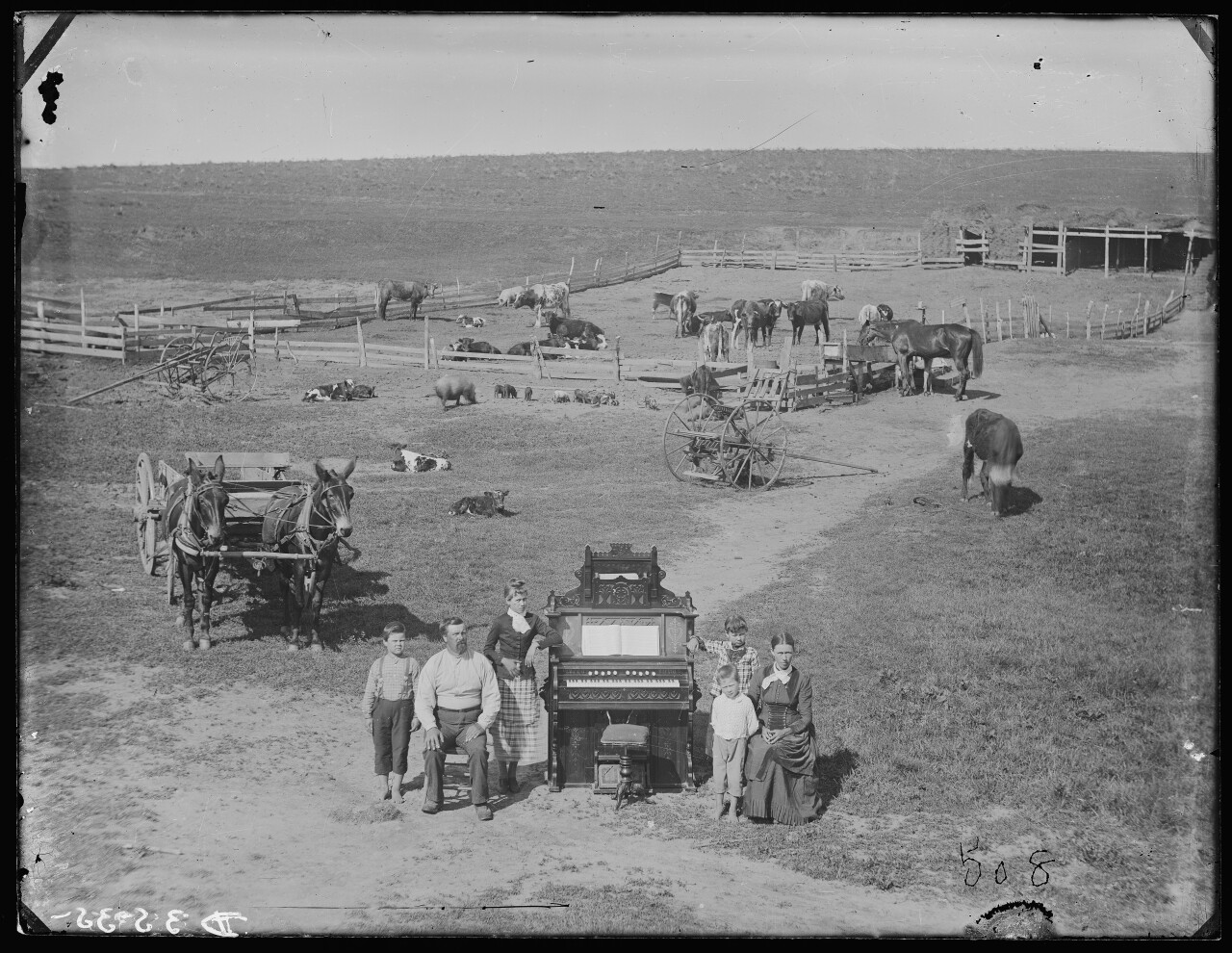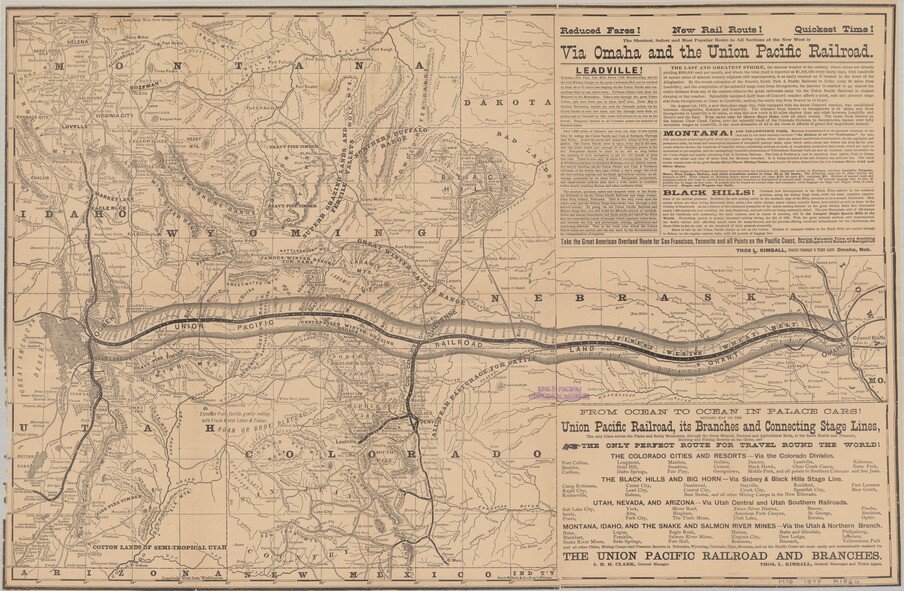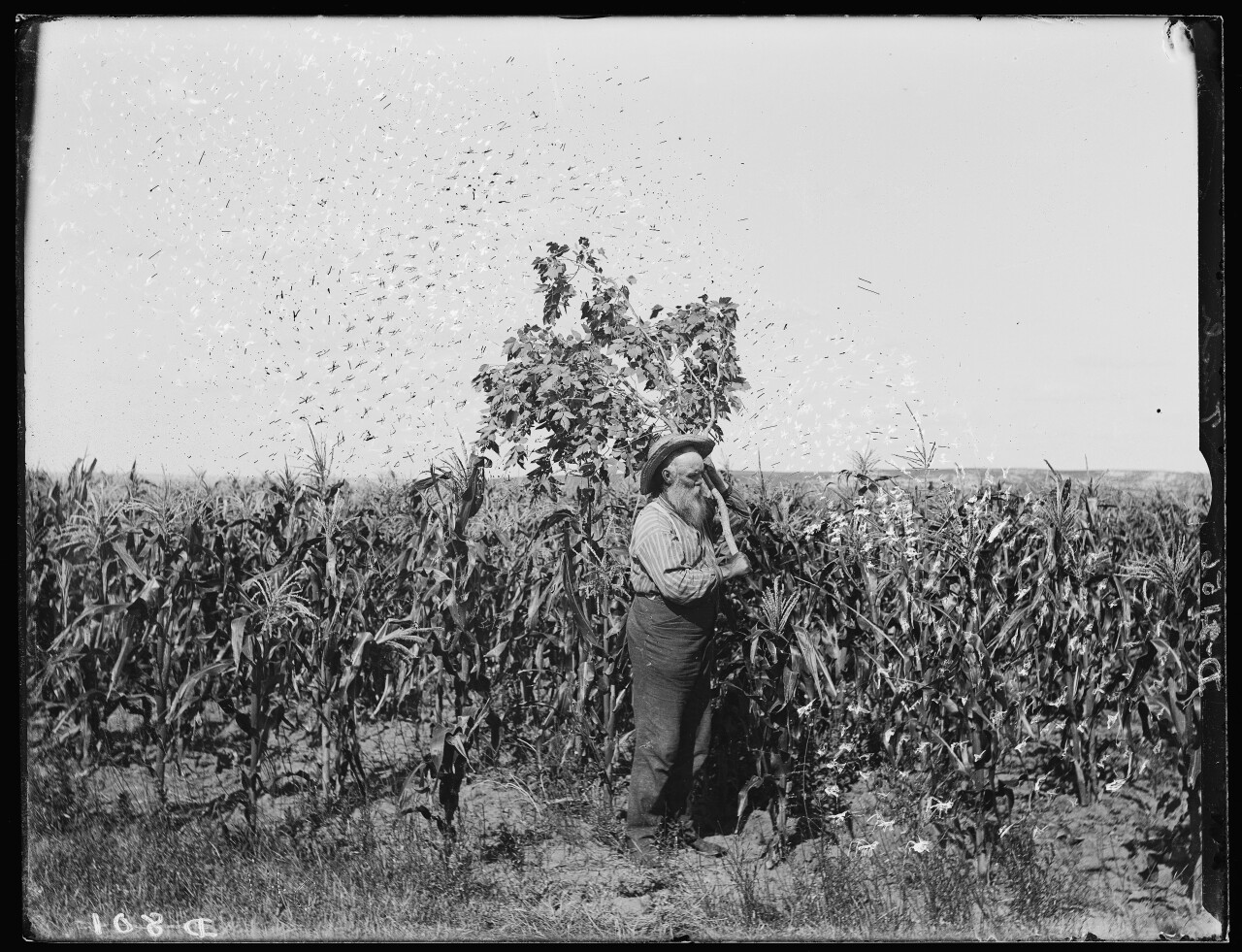Forgive George Barnes if he looks a little grim.
No one cheesed for the camera in the 19th century.
But Barnes’ jaw is clenched and he’s frowning slightly beneath his horseshoe mustache. He stared hard at the camera in 1887, the day pioneer photographer Solomon Butcher showed up to take his family’s photo. Ol’ George had ample reason to mean-mug Butcher and homesteader life in general, you will learn if you glance at the sod house standing — barely standing — behind him.
The night before the family photo, it had rained. Hard. That would be fine if the Barnes family had lived, as most of us now, in a home of wood or brick. But they lived in a soddie, same as hundreds of thousands who wandered into the wilderness of this new state called Nebraska hoping to earn free land and free themselves. From East Coast poverty or European famine, the horrors of American slavery or something intangible they couldn’t describe.
The rain had soaked the sod roof, weighing it down. The decaying pole meant to hold the roof had snapped. The whole thing had come down on itself, like a bad metaphor, covering every item the family owned in mud.
“All escaped injury, but the disaster left them homeless,” wrote famed Nebraska historian John Carter in his book on Butcher’s photography.
The year before, George Barnes’ wife had died of an unknown illness. Barnes was raising three children by himself, while he tried to make crops grow without water or a tractor.
Then his house caved in.
It’s a good reason to grimace.
The experience of George Barnes is much more real than the fictions we have come to believe about the Homestead Act that “settled” much of Nebraska — and also understand how that experience is still embedded on Nebraskans’ DNA.
The homesteaders of Nebraska had it rough.

Your soddie might collapse. Your spouse or children might die. Your land may refuse to produce wheat, maybe because you have no idea how to farm, and you may grow gaunt and intensely homesick for Cincinnati or Copenhagen or whatever map dot from which you arrived.
And we haven’t yet considered the blizzards. Or the locusts.
All these things might and did happen, Nebraska historians say, and they lead us to one question George Barnes must have asked himself a thousand times.
What in God’s name am I doing here?
* * *
More than a century after George Barnes’ house caved in, a woman named Rhonda Seacrest stood in a central Nebraska country cemetery and asked herself the same question.
Seacrest, whose husband Jim Seacrest was then president of a group of western Nebraska family newspapers, had agreed to take her mother and friends to a funeral.

The burial took place in a cemetery near the village of Merna, just north of Broken Bow.
It was February. Gray. Twenty degrees. The cemetery sat on a little hill, and when Seacrest stood and faced the horizon, the unrelenting wind stung her eyes, lashed her face, practically shook the questions from her.
Why do I stay here? Why did…anybody…ever…stay here?
Rhonda Seacrest and Jim, who died in 2016, answered that question by helping make their part of Nebraska a better place. They raised money for performing arts centers and hospital renovations in North Platte. She supports programs that transport art and opera from eastern Nebraska cities to western Nebraska schoolchildren. (She’s also a supporter of Flatwater Free Press.)
The questions Seacrest asked herself prompted another: Why do Nebraskans celebrate people whose main interest in our state was passing through?
Our license plate once featured a covered wagon. We venerate attractions like Chimney Rock originally used as 19th century signposts for people headed west. This way to California! Veer right for Oregon!
It caused Seacrest to fund a new art project, one focused on what she and the artist view as the homesteading reality that deserves to be celebrated.
Hearing that story about standing in a cemetery in the dead of Nebraska winter caused us to devise a new series, one we’ll call: Why We Stay.
“Why do I stay here?” is a question nearly every Nebraskan asks at some point, usually in February. We stay despite the cold, the wind, the gray, high property taxes that bug some, the right-wing politics that frustrate others and the “flyover country” perception that miffs everyone. This occasional series will examine the very real issues of depopulation and brain drain through the lens of Nebraskans who did stay and decided to do something to make their urban, suburban or rural place better.
To understand why we stay, we first need to understand the original crew that came and stayed, further crowding out the already devastated Native tribes who already called the area home.
I started talking to historians about the homesteaders and quickly realized: Most of us 21st century Nebraskans, myself included, have no idea who they really were.
* * *
Quick quiz: How did most Nebraska homesteaders reach the land they claimed?
They rode west across the prairie in covered wagons, right, which they would then circle when attacked by warring Native Americans. Yes?
No. Most people who homesteaded in Nebraska rode the train. Most had little contact with Native Americans, and what contact they did have tended to be trade-related and friendly.

This picture in our heads, historians say, is a warped, Hollywood-influenced picture of earlier settlers — people who rumbled West in the decades before the Civil War.
The Homestead Act took effect on Jan. 1, 1863, promising Americans the right to claim 160 acres of land that would be theirs if they built a house and grew crops for five years. Homesteaders began to come to eastern Nebraska at the tail-end of the Civil War, but didn’t begin settling parts of central, western and northwest Nebraska until the 1880s or even later.
It wasn’t a land rush like Oklahoma’s. Or the Gold Rush in California. It wasn’t a rush at all. Homesteaders showed up steadily for three decades, fanning out, first near the Missouri River and then throughout the state, in search of decent land that wasn’t already claimed.
They took the train.
“If the railroad comes to that community in 1877, then homesteading explodes in 1878,” said Jonathan Fairchild, historian at Homestead National Historical Park near Beatrice. “Speculators would try to buy up land where they thought the railroad would go next. A lot of these early communities would live or die based on whether they got the railroad."
“It was hugely important,” he added.
Many who stepped off these trains didn’t arrive thinking that the land would be theirs forever, an heirloom passed down generations.
Many planned to turn a profit and skedaddle.
Only six months after arriving, some homesteaders “commuted” their land, paying $1.25 an acre to quickly get the land title instead of farming it for five years. They borrowed against the land to buy equipment, or sold it and moved on.
And a giant chunk of Nebraska homesteaders — as many as 20%, Fairchild said — who did farm their land for five years sold it within a single year of actually getting the deed.
“Most people didn’t come to stay,” said David Wishart, a University of Nebraska-Lincoln geography professor and editor of “Encyclopedia of the Great Plains.” “You really have to understand the degree of speculation that went on in the frontier. As opposed to the Jeffersonian ideal of the yeoman farmer. He was here. But he was definitely a minority.”
Taking land, farming it for five years and then selling it at the first opportunity made a mountain of sense to many Nebraska homesteaders, who often came from desperate circumstances.
Roughly one out of five arrived in Nebraska directly from a European country, according to research done by Rick Edwards, retired director of UNL’s Center for Great Plains Studies, and a team of researchers. Many others were brand-new American citizens, who had moved from, say, Germany to Ohio to central Nebraska in short order.
European aristocrats weren’t chucking the good life on that continent to start anew. Most of those who came were poor, people who had no other way to own land. Often, these immigrants were lured by laughably incomplete portraits of Plains life. One advertisement promised East Coast residents that no flies existed in South Dakota.
Another ad, paid for by the railroads and printed in Czech newspapers: “You see this farmer plowing the soil and gold coins coming out,” Fairchild said. ”Literally, it was, ‘Come here you will be rich in America!’”
People who already had money didn’t often trifle with the Homestead Act. They didn’t want to wait any more than 21st century millionaires want to wait in line at Disneyland.
That era’s rich instead bought the Nebraska land they wanted, either from the railroads — who owned a lot — or by purchasing military bounty land warrants, which allowed military veterans to claim land and sell it.
And who could blame them?
As the story of George Barnes suggests, being a homesteader was harder than we can fathom.
Here’s an incomplete list of the things historians mentioned when asked about those difficulties:
Drought. Heat. Blizzards. Wind. A winter fiercer than many had faced before. A spring thaw and rains that turned ground into gumbo and made it impassable for weeks.
Wind. Falling crop prices. The farming crash of the 1890s. Debt. Figuring out how to plow over the land with inferior equipment and little farming experience. Getting kicked by a horse, getting laid up for two months, and failing to plant. No timber to build fences, furniture and houses. Wind.
Loneliness. Childbirth. Cholera. Measles. Whooping cough. Typhoid. Medical care a day’s ride away. Frequent death of children. Frequent death of spouses. Bugs. And…
“The 1870s, of course, had the locust plagues,” Edwards said.
Come again?
“Yes, the locust plagues. No one knew about this. There was no knowledge that this could happen. And they came and devastated everything.”

One of the things homesteaders didn’t face, the historians say: Imminent threat from Native Americans. That, they say, is largely a myth perpetuated by popular culture.
Most Plains tribes had been utterly decimated, resettled or pushed onto reservations by the time large numbers of homesteaders started to populate swaths of Nebraska. Relationships between these Native Americans and nearby white settlers were often cordial, historians say, and based on trade. There was occasional, isolated and famous violence, but it never touched the lives of the vast majority of white settlers.
The main violence, both physical and cultural, was against Native Americans themselves, said Wishart, who authored “An Unspeakable Sadness,” a seminal book on the dispossession of Native lands.
“The main motivation of Indian policy was to get land for whites,” he said. “The (US government) saw it as a trade, basically, ‘We will give you our civilization if you give us your lands.’ But of course, that meant rejecting everything you knew as Indian. It was a policy of cultural genocide…and it meant that (by the Homestead Act) Indians were no real threat.”
There were plenty of real threats.
Edwards was one of the first researchers to try to count the number of homesteaders who claimed Nebraska land and then actually made it to the five-year mark.
His answer: When given a free 160 acres, the promise of gold coins popping from the soil, the promise of forever altering your family’s economic trajectory…Roughly 55% of Nebraska homesteaders made it. Barely better than a coin flip.
The rest got sick, went broke or cut bait and left. And then, of course, many of those who did make it sold out as soon as they could, and vanished, too.
So, how to differentiate those who stayed from those who didn’t?
“How did people get out of a trench in World War I and run towards the barbed wire?” Edwards asked in response.
The people who stayed faced an incredible array of enemies, calmed their terrors, dove out of metaphorical trenches and sprinted into gunfire for years. Decades.
They were leathery and obstinate.
They were among the first residents of this new state called Nebraska.
* * *

Not long ago, Rhonda Seacrest was asked to donate to the renovation and expansion of Chimney Rock. She said 'no' because she doesn’t believe in spending money celebrating the Americans who passed through to California on the 19th century version of the interstate. Then she started thinking.
“I decided it was time to put a face on the people who actually stayed here,” she said.
She met an Elkhorn-based sculptor named David Biehl and told him that she wanted to honor those who stayed. Her Nebraska ancestors stretch back to the Homestead Act time period. So do Biehl’s.
“I think I know what you want,” Biehl said.
He read books about homesteaders. He re-read Willa Cather novels. He tried to imagine the loneliness, the setbacks, the wild risk of moving halfway across the country or the world to an untamed prairie and saying: Here is where we live now.
“It’s amazing to me that people took that chance with their families,” he said.
He sculpted a fictional family of five, with a plow and a team of horses he’s working on now.

Biehl’s homesteaders aren’t glorified. The family struggles with heat, hardship, that wind. They are tired, hungry, anxious. But the plaques attached with the sculptures also contain hope: Hope that a little rain will bring a bountiful harvest. Hope that life will get better soon.
Recently they held an unveiling ceremony at the Archway near Kearney, where the statues now stand. Seacrest and Biehl watched, gratified, as the first school children walked past the new sculptures, studied the 19th century figures of children their same age, and talked about what that must have been like.
“We have to put a face on the past because it helps us to identify who we are today, and to face the obstacles we must face today,” she said.
That face, Edwards said, was more complicated than the image of a solitary figure working a plow, going it alone. Going it alone is the final myth of the Nebraska homesteader.
“What really happened is that people relied on their neighbors a lot,” he said.
Neighbors traded labor, farming equipment, medical services. They entertained one another, speculated about the weather or the crops or the markets. They worked together “because it was the only real way to conquer the shared obstacles they all had.”
Not much is known about what happened to poor George Barnes after his sod house caved in, but it’s a good bet, historians think, that his neighbors rallied and helped him rebuild.
The only thing we know for sure about Barnes is that he died in 1910. The owner of a Nebraska soddie died 23 years after his famous Nebraska photo in the place where you would most expect.
South Dakota.
SEE MORE: Dewitty became ‘springboard’ for Black Nebraska homesteaders
The Flatwater Free Press is Nebraska’s first independent, nonprofit newsroom focused on investigations and feature stories that matter.
Download our apps today for all of our latest coverage.
Get the latest news and weather delivered straight to your inbox.







